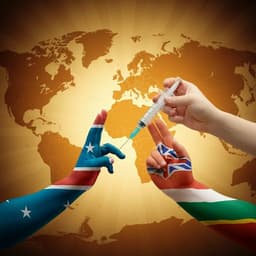
Social Work
Resolving the unintended consequences of collective co-production through group co-production: a case study in Shanghai
T. Zhao, J. Yuan, et al.
Discover how collective co-production during the COVID-19 pandemic in Shanghai provided crucial support for people with disabilities despite disruptions to formal services. This research, conducted by Ting Zhao, Junao Yuan, Zhongsheng Wu, and Dongsheng Xu, reveals key insights into enhancing emergency management through innovative self-organized groups.
~3 min • Beginner • English
Introduction
The COVID-19 pandemic disproportionately affected socially vulnerable populations. Co-production between government and society is widely seen as a way to mitigate negative disaster impacts, yet the literature often conflates types of co-production and overlooks tensions between them. This study examines how collective co-production (e.g., lockdowns and other mandatory measures) interacted with and sometimes undermined formal service provision for people with disabilities (PWD) in Shanghai, and how group co-production via self-organized neighborhood groups compensated to maintain service resilience. The research question centers on how self-organized groups for PWD helped achieve service resilience during strict epidemic prevention and control (late January–early May 2020) when formal services were suspended, and what this reveals about the relationship and tensions between collective and group co-production.
Literature Review
The paper reviews definitions and types of co-production. A key debate concerns whether co-production requires voluntary citizen participation or can include involuntary compliance; the study adopts the inclusive view that both count as co-production. Building on Brudney and England (1983), the paper distinguishes individual, group, and collective co-production, noting that recent work has emphasized individual vs. collective while interactions between collective and group remain underexplored. In pandemic contexts, two dominant co-production forms are identified: (1) compliance with government regulations (e.g., quarantine, masking), often facilitated by digital information disclosure; and (2) delivery of necessary services (e.g., psychological counseling, supply distribution), frequently via volunteers and self-organized groups. The analytical framework posits a potential tension: collective co-production through strict, one-size-fits-all measures can unintentionally disrupt third-sector operations (especially GONGOs and funded nonprofits), suspending formal services for vulnerable groups. Group co-production by self-organized, neighborhood-based associations can then step in to provide tailored material and psychosocial support, thereby restoring service resilience. Resilience is conceptualized as the system’s capacity to resist, absorb, and adapt to shocks to avoid service system failure. The framework suggests complementary roles: group co-production mitigates adverse welfare impacts of collective measures and can increase public cooperation, improving the overall effectiveness of collective co-production.
Methodology
Case study of W District, Shanghai. Case selection: Shanghai has actively advanced collaborative governance and government purchase of services; W District emphasized support for self-organized groups for PWD and experienced very few infections among PWD during the three-month control period, offering a revealing context. The research team has tracked local reforms since 2010 and maintained close ties with the Disabled Persons’ Federation and nonprofits, facilitating access. Study period: primarily late January to early May 2020 (strict control), with post-reopening fieldwork. Data collection: (1) Post-reopening (May 2020) interviews and observations with formal nonprofits: 12 GONGOs serving PWD, 1 infrastructure nonprofit (overseeing publicly funded programs), and 5 independent nonprofits; plus three government officials (district-wide PWD services, a sub-district PWD services official, and a district community governance official). These confirmed citywide closures and program suspensions. (2) Approximately 70 semi-structured interviews with leaders or key members of self-organized PWD groups, conducted in three rounds: October 15–16, 2020 (28 neighborhood groups in J sub-district; forum with 9 members from three other sub-districts); December 2020 (20 additional interviews during site visits); and August 2021 (training event followed by interviews with 13 additional leaders). Total N=70, representing about 22.0% of the 318 self-organized groups in W District. Interview topics included group formation timelines, activity frequency in 2019 vs 2020, services provided during lockdown, modes of interaction (online/offline), and pandemic-related activities. (3) Documentary review of W District Disabled Persons’ Federation website, quarterly reports, and news items documenting self-organized group activities. Descriptive analysis synthesized interview, observational, and documentary evidence to map changes in service provision and the roles of collective vs group co-production.
Key Findings
- Formal services discontinued due to collective co-production: Citywide epidemic control mandated closures of all public service facilities from the Shanghai Disabled Persons’ Federation to local branches. The 12 GONGO-run service agencies closed facilities for about four months (reopened mid–late May 2020); independent nonprofits largely suspended services, with limited online activity; overall performance deemed unsatisfactory by officials. Demand for services increased as access fell. - Self-organized groups restored service resilience: W District had 318 neighborhood self-organized groups (≈5,946 members; ≈20.1% of PWD), typically 8–15 members per group; 45.0% (140) of leaders district-wide were PWD; in J Street, 80.4% of leaders were PWD (41/51). Many groups had operated for over a decade, building stable mutual-aid networks. - Activity frequency: Reported activity frequency in the past year (pre-2020) was about 4–14 times higher than in 2020. - Pandemic-related activities: 80% of interviewed groups conducted pandemic-related activities. - Service modalities: 90% interacted via phone/WeChat; 56% conducted home visits, reflecting digital divide challenges among elderly, intellectually disabled, and blind PWD. - Four main service types provided by self-organized groups during lockdown (Fig. 3 proportions among interviewed groups): 1) Epidemic control and basic living support (77%): disinfection of common areas; sourcing masks; health education; haircuts for elderly/PWD; post-reopening in-person activities (lectures, stress management, emotional support, competitions). 2) Assistance for high-need PWD (79%): purchasing medicines (especially for mental health needs); in-home disinfection and care; crisis de-escalation and engagement (e.g., straw weaving) to stabilize mental health. 3) Delivering food/meals to quarantined PWD (26%): daily necessities delivery and meal provision, enabling compliance with quarantine and maintaining community connection. 4) Donations of money/goods (31%): financial or in-kind contributions by PWD and members to support epidemic prevention and community needs. - Leadership and group characteristics: Leaders often elderly; successful groups had caring, supported leaders; challenges included severe mobility impairments limiting participation, communication barriers among Deaf persons, low youth participation, and leadership succession concerns. Overall, self-organized groups compensated for service gaps created by formal closures and maintained a level of service continuity for PWD.
Discussion
The findings address the research question by demonstrating that collective co-production through stringent, uniform epidemic measures unintentionally disrupted formal nonprofit service delivery for PWD, while group co-production via neighborhood self-organized groups sustained material and psychosocial support, thereby preserving service resilience. The results illuminate a nuanced interaction: group co-production mitigates welfare externalities of collective measures, helping maintain community stability and potentially reinforcing public willingness to comply with collective measures. The study advances co-production theory by differentiating organizational forms within the third sector (formal nonprofits vs informal grassroots associations) and showing how loose coupling through informal, locally embedded groups sustains services when tightly coupled, government-dependent providers suspend operations. It also contributes to debates on equity and effectiveness in co-production by showing that tailored, group-level practices can reduce harms to vulnerable populations. Policy implications include prioritizing support for formalized, enduring self-organized groups (resources, appropriate decentralization, relaxed formation thresholds, volunteer recognition, and platforms for information/experience exchange) to bolster emergency governance capacity.
Conclusion
The study shows that during Shanghai’s early 2020 lockdown, collective co-production (mandatory prevention and control) shuttered formal services for PWD, creating unintended harms, whereas group co-production by self-organized neighborhood groups provided essential material and counseling services through online and offline means, sustaining service resilience. The paper contributes by clarifying tensions and complementarities between collective and group co-production, highlighting the role of informal, locally embedded associations in maintaining continuity for vulnerable groups, and underscoring the value of loose coupling in service systems. Future research should examine interactions among broader co-production types (e.g., group vs individual) and identify the organizational, community, and policy factors that enable group co-production to neutralize negative impacts from collective measures across diverse contexts.
Limitations
- Single-case design focused on W District, Shanghai; generalizability is limited. - The analysis centers on the relationship between collective and group co-production; interactions with other types (e.g., individual co-production) were not examined. - While the study finds that group co-production mitigates negative impacts of collective measures, it does not fully identify or test the causal factors and mechanisms enabling this mitigation.
Related Publications
Explore these studies to deepen your understanding of the subject.







